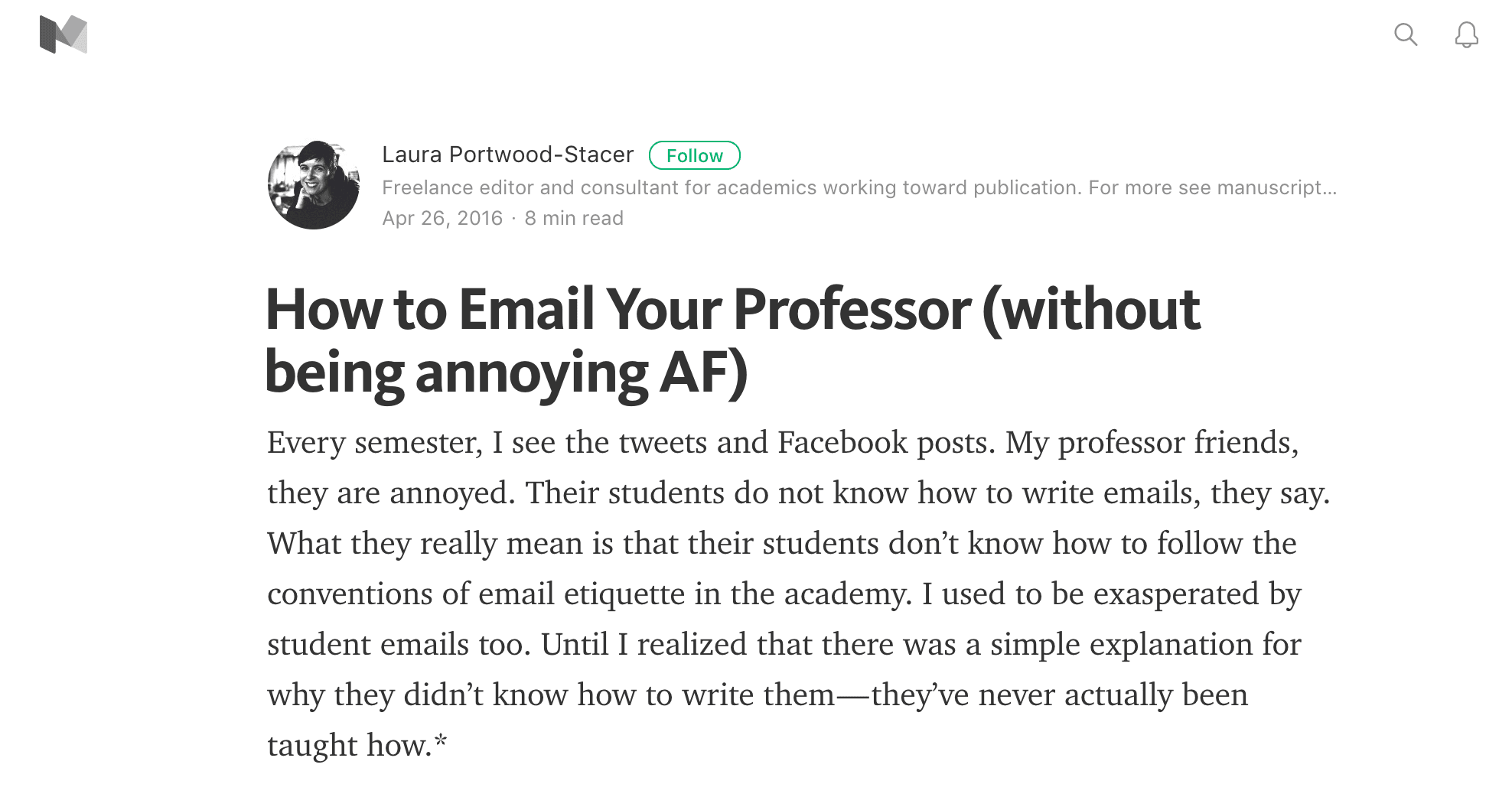Emailing your professor can be daunting. You want to sound respectful and not annoying.
Crafting the perfect email is an art. You need to balance politeness with clarity. Your professors are busy people, and your email should respect their time. This guide will help you write emails that get noticed and answered without causing irritation.
From addressing your professor correctly to getting your point across clearly, we cover it all. Follow these tips, and you’ll communicate effectively without being annoying. Ready to make your emails stand out? Let’s dive in and learn how to email your professor the right way. Understanding the nuances of tone and language can elevate your email game significantly. Additionally, knowing how to respond to professor emails can foster a positive relationship and encourage open communication. With these strategies in hand, you’ll be well-prepared to engage thoughtfully with your professors.

Credit: lauraportwoodstacer.com
Subject Line Tips
Emailing your professor can be a daunting task. The subject line is crucial. It sets the tone for your email. A well-crafted subject line grabs attention. It ensures your email gets read. Here are some tips for writing effective subject lines.
Be Clear And Concise
Your subject line should be direct. Avoid long sentences. Get to the point quickly. For example, “Question about Homework” is clear. It tells the professor exactly what to expect. Use specific words. They help convey your message. Clarity is key.
Avoid Clickbait
Do not use misleading subject lines. Professors appreciate honesty. Clickbait can be annoying. It can also confuse. For instance, “Important Information Inside!” is vague. Instead, be specific. “Request for Office Hours” is much better. It is straightforward. It respects the professor’s time.
Proper Salutations
Communicating with professors can be daunting. Using proper salutations sets a respectful tone. It shows you value their time and position. This section explores how to greet your professor in an email. Learn how to start your email professionally and respectfully.
Use Formal Greetings
Always start with a formal greeting. Avoid casual phrases like “Hey” or “Hi there.” Instead, use “Dear” or “Hello.” These show respect and professionalism. A respectful greeting helps make a good impression.
Include Titles
Address your professor by their title. Use “Dr.” if they have a Ph.D. Use “Professor” if unsure. Never use just their first name. It can seem disrespectful. Check your university’s website for their proper title. It shows you care about addressing them correctly.
Email Structure
When emailing your professor, the structure of your email is crucial. A well-organized email helps convey your message clearly and shows respect for your professor’s time. Here is a guide on how to structure your email effectively.
Start With Introduction
Begin with a polite greeting. Use “Dear Professor [Last Name]” to address your professor. Introduce yourself briefly. Mention your name and the course you are taking. This helps your professor know who you are.
State Purpose Early
Clearly state the purpose of your email in the first few sentences. Be direct and specific about what you need. This makes it easier for your professor to understand your request. Avoid long, drawn-out explanations.
For example, you can say, “I am writing to ask about the assignment due next week.” This gets straight to the point and makes your email easy to read.
Tone And Language
Crafting emails to professors can be tricky. Use respectful language and a polite tone. This helps avoid sounding annoying.
When emailing your professor, your tone and language play a crucial role in how your message is received. A well-written email can help you get the support you need without coming off as annoying or unprofessional. Let’s delve into some key aspects to keep in mind.
Be Polite And Respectful
Always start your email with a polite greeting. Address your professor formally, using “Dear Professor [Last Name]” or “Hello Dr. [Last Name].” This shows respect for their position and sets a professional tone.
Make sure to use “please” and “thank you” when making requests. These small words can go a long way in making your email sound courteous and respectful.
End your email with a polite closing, such as “Sincerely” or “Best regards,” followed by your name. This leaves a positive impression and shows that you value their time.
Avoid Slang
Using slang or overly casual language can make you appear unprofessional. Stick to standard English and avoid abbreviations like “u” instead of “you” or “thx” instead of “thanks.”
Consider this: would you use the same language in a job application? If the answer is no, then it’s probably not suitable for an email to your professor.
Write in complete sentences and avoid using emojis. While they might be fun in a text to a friend, they are not appropriate in a professional email.
Being mindful of your tone and language can make a big difference. It shows that you respect your professor’s time and helps ensure that your message is taken seriously. So, what steps will you take to improve your email etiquette? Additionally, consider taking a moment to review your message before hitting send, ensuring that it conveys your intended meaning without unnecessary emotion. If you find yourself feeling frustrated, it might be helpful to research how to express anger professionally, as this can guide you in framing your thoughts constructively. Practicing empathy and clarity in your communications will foster better interactions and a more positive relationship with your professors.
Content Relevance
Content relevance is crucial when emailing your professor. Your email should be clear and focused. Avoid including unnecessary information. This ensures your message is understood quickly. Professors receive many emails daily. Relevant content respects their time and increases the chance of a prompt response.
Stay On Topic
Keep your email focused on one subject. Do not mix multiple topics in one email. This can confuse your professor. If you have different questions, send separate emails. Clearly state the purpose of your email in the first sentence. This sets the context for the reader.
Be Brief
Long emails can be overwhelming. Stick to the main point. Use short sentences and paragraphs. This makes your email easier to read. Avoid unnecessary details. Only include what is essential. Brief emails are more likely to get a quick response.

Credit: x.com
Attachment Etiquette
When emailing your professor, you may need to send attachments. Whether it’s a paper, project, or proof of absence, using proper attachment etiquette is essential. Poorly managed attachments can clutter inboxes and create frustration. Let’s explore how to ensure your attachments are helpful, not annoying.
Limit File Size
Professors receive numerous emails daily. Large attachments can slow down their inbox and may even bounce back. Keep file sizes small.
Compress documents and images. Convert files to PDF when possible. This ensures readability and reduces size.
For videos, use a sharing link instead. Upload to a cloud service like Google Drive or Dropbox. This saves space and is easier to access.
Mention Attachments
Always mention attachments in the body of your email. This prevents confusion and ensures your professor knows what to expect.
Write a brief description. For example, “Attached is my research paper on climate change.” This context helps your professor understand the content.
If sending multiple files, list them clearly. “I’ve attached my essay, bibliography, and data analysis.” This avoids any guesswork.
Have you ever sent an email with an attachment, only to forget the attachment? It happens. Double-check before hitting send.
By following these steps, you can email your professor without being annoying. Respect their time and keep your communication clear. Your efforts will be appreciated.
Follow-up Strategy
Crafting the perfect email to your professor can be challenging. Even more so, knowing how and when to follow up is crucial. Here, we will discuss the follow-up strategy to ensure you do not come across as annoying. This involves waiting for a response and being patient.
Wait For Response
After sending your initial email, give your professor some time. Professors are often busy with classes, research, and meetings. Do not expect an immediate reply. Waiting a few days is usually a good practice. This shows respect for their time and schedule.
Be Patient
Patience is key in the follow-up strategy. If you do not hear back in a week, it is okay to send a gentle reminder. Start with a polite greeting. Mention your previous email and kindly ask if they had a chance to look at it. Always keep your follow-up email short and to the point. This shows you value their time and are considerate.

Credit: www.scribd.com
Common Mistakes
Reaching out to your professor via email can be intimidating, especially when you worry about coming off as annoying. Understanding common mistakes can help you avoid them, ensuring your communication is effective and respectful.
Avoid Excessive Emails
One of the biggest mistakes students make is sending too many emails. Professors are busy and receive tons of messages daily. Sending multiple emails in a short period can be overwhelming and irritating.
Instead, consolidate your questions into one email. If you don’t get a response immediately, give it a few days before following up. This shows patience and respect for their time.
Proofread Before Sending
Sending an email with typos and grammatical errors can make you appear careless. Professors appreciate well-written and clear messages. Take the time to proofread your email before hitting send.
Reading your email aloud can help catch mistakes. Also, consider using tools like Grammarly to double-check your work. A polished email demonstrates your professionalism and attention to detail.
Reflect on your own experiences. Have you ever received a poorly written email? How did it make you feel? Keep this in mind when composing your messages to your professor.
By avoiding these common mistakes, you can communicate more effectively and build a positive relationship with your professor. What other strategies have you found helpful when emailing your professors?
Frequently Asked Questions
How To Start An Email To A Professor?
Begin with a polite greeting, such as “Dear Professor [Last Name],” followed by a concise introduction of yourself and the purpose of your email. I hope this message finds you well. I am reaching out to inquire about the concept of an “email username,” specifically the email username definition and examples, as I believe this knowledge could greatly benefit my understanding of effective communication. If you could provide any insights or resources on this topic, I would greatly appreciate it.
What Should I Include In The Subject Line?
Make your subject line clear and specific. Include keywords related to your query or topic. Avoid vague phrases and ensure it reflects the content.
How To Write A Polite Email To A Professor?
Use formal language, be respectful, and avoid slang. Clearly state your purpose, provide necessary details, and thank them for their time.
How To Ask For Help In An Email?
Politely state your problem, be specific, and ask directly for assistance or advice. Show appreciation for their help.
Conclusion
Emailing your professor doesn’t have to be stressful. Follow basic etiquette. Keep messages clear and respectful. Avoid being too casual or too formal. Proofread your email before hitting send. Respect their time and be patient. Ask questions politely and thank them for their help.
These simple steps can make communication smoother. You’ll build a better relationship with your professor. Good luck with your studies!
